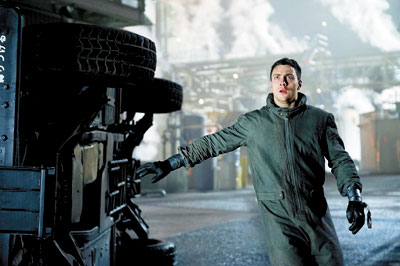
It takes nearly an hour for Godzilla to make his entrance* in a film that begins with lots of debates* about seismic* activity that can only point to one thing: huge prehistoric creatures awakening from their millennia-long* sleep.
Where traditional Godzilla stories presented the monster as a warning against nuclear proliferation* after the bombings of Hiroshima and Nagasaki, this version suggests “all those nuclear tests” the United States conducted in the Pacific between 1946 and 1962 weren’t tests, but an effort to deal with a giant amphibious* dinosaur. This time, it’s Filipino mining that wakes up a giant MUTO* — or “Massive Unidentified Terrestrial Organism.”
In a “Jurassic Park”-like prologue*, two scientists (Ken Watanabe and Sally Hawkins) helicopter* into a huge computer-generated quarry*, where they discover two perfectly preserved, chrysalis*-shaped pods* connected to a huge skeleton. One of the pods has broken, with whatever escaped digging a trail to the sea. The other is taken back to the States for further study, close to Las Vegas.
Meanwhile, in Tokyo, Joe Brody (Bryan Cranston) and his wife, Sandra (Juliette Binoche), live a short drive from the nuclear facility where they both work. Tragedy* strikes, nuclear reactors implode* and the couple’s son Ford is left parentless.
The story picks up again 15 years later with Ford (Aaron Taylor-Johnson) serving as an explosive ordnance disposal* operator for the U.S. Navy — a job that makes him qualified to defuse* the ticking atomic device that threatens to blow San Francisco off the map later in the film.
The biggest problem with this film is that something seems to have been forgotten. That is: The hero of any Godzilla movie is — or should always be — Godzilla. This one presents the mighty dino as a sort of scaly* Shane*: When big radioactive creatures start throwing their weight around, he walks out of the deep to defend the helpless, then rides off into the distance every bit as mysterious* after the deed is done.(SD-Agencies)
|

